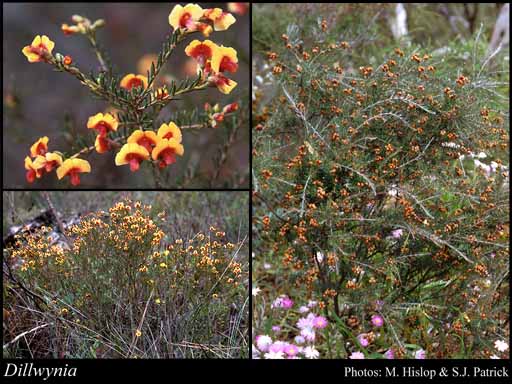- Reference
- Ann.Bot. 510 (1805)
- Name Status
- Current

Scientific Description
Family Papilionaceae. Mirbelieae.
Sometimes included in Leguminosae.
Habit and leaf form. Ericoid shrubs; evergreen. Leaves cauline. Plants with neither basal nor terminal concentrations of leaves. Mesophytic, or xerophytic. Leaves small to medium-sized; alternate (or ‘scattered’); spiral; not decurrent on the stems; petiolate to subsessile; non-sheathing; simple; epulvinate. Leaf blades dorsiventral; entire; solid; terete, or semi-terete, or solid/angular; grooved adaxially; without cross-venules. Leaves without stipules. Leaf blade margins entire; involute. Leaf anatomy. Complex hairs present. Complex hairs peltate.
Reproductive type, pollination. Fertile flowers hermaphrodite. Unisexual flowers absent. Plants hermaphrodite. Entomophilous.
Inflorescence and flower features. Flowers solitary (rarely), or aggregated in ‘inflorescences’; not crowded at the stem bases. Inflorescence few-flowered. Flowers in racemes, or in corymbs. Inflorescences simple. The terminal inflorescence unit racemose. Inflorescences terminal, or axillary. Flowers pedicellate; bracteate (the bracts not trifid). Bracts deciduous (small, very caducous). Flowers (bi-) bracteolate (on the pedicels). Bracteoles deciduous. Flowers very irregular; zygomorphic. The floral asymmetry involving the perianth, or involving the perianth and involving the androecium. Flowers papilionaceous; tetracyclic. Floral receptacle developing a gynophore, or with neither androphore nor gynophore. Hypogynous disk present; intrastaminal; annular. Perianth with distinct calyx and corolla; 10; 2 -whorled; isomerous. Calyx present; 5; 1 -whorled; gamosepalous; five lobed (not ribbed). Calyx lobes markedly shorter than the tube, or about the same length as the tube, or markedly longer than the tube. Calyx imbricate; exceeded by the corolla; bilabiate (the posterior pair of members broader and more or less connate); non-fleshy; persistent; non-accrescent; with the median member anterior. Corolla present; 5; 1 -whorled; appendiculate, or not appendiculate. Standard not appendaged. Corolla polypetalous, or partially gamopetalous. 2 of the petals joined. The joined petals anterior (the keel). The wings of the corolla free from the keel; not laterally spurred (but the apices of the wings downcurved and enlarged). Standard ‘normally’ developed; emarginate (broader than long). Keel conspicuously exceeded by the wings (straight); not long-acuminate/beaked; neither coiled nor spiralled; not bent and beaked. Corolla imbricate; yellow, or orange and red; not fleshy; deciduous; non-accrescent. Petals clawed. Androecial members definite in number. Androecium 10. Androecial sequence determinable, or not determinable. Androecial members free of the perianth; all equal to markedly unequal; free of one another; 1 -whorled. Androecium exclusively of fertile stamens. Stamens 10; all more or less similar in shape; diplostemonous; both opposite and alternating with the corolla members; filantherous. Anthers separate from one another, or connivent; all alike; dehiscing via longitudinal slits; latrorse, or introrse. Gynoecium 1 carpelled. The pistil 1 celled. Carpels reduced in number relative to the perianth. Gynoecium monomerous; of one carpel; superior. Carpel stylate. Style hooked (rather short and thick, hooked below the apex). Style terete. Stigmatic tissue terminal. Carpel 2 ovuled. Gynoecium median. Ovary shortly stipitate, or sessile to subsessile. Stigmas capitate. Ovules shortly funicled.
Fruit and seed features. Fruit stipitate to sessile; non-fleshy. The fruiting carpel dehiscent; a legume. Pods somewhat elongated (obovoid); not triangular; straight; becoming inflated, or not becoming inflated; somewhat compressed, or terete; not constricted between the seeds; not transversely septate; wingless; not internally hairy. Fruit 1 celled. Dispersal unit the seed. Fruit 1–2 seeded. Seeds reniform (not triangular, not lobed); not mucous; arillate. Embryo bent (radicle inflexed). Testa non-operculate; conspicuously colour-patterned (mottled).
Geography, cytology, number of species. Native of Australia. 2n = 14 (21, 28). A genus of 12–16 species; 6 species in Western Australia.
Taxonomic Literature
- Wheeler, Judy; Marchant, Neville; Lewington, Margaret; Graham, Lorraine 2002. Flora of the south west, Bunbury, Augusta, Denmark. Volume 2, dicotyledons. Australian Biological Resources Study.. Canberra..
- Grieve, B. J.; Blackall, W. E. 1998. How to know Western Australian wildflowers : a key to the flora of the extratropical regions of Western Australia. Part II, Dicotyledons (Amaranthaceae to Lythraceae). University of W.A. Press.. Nedlands, W.A..
- Marchant, N. G.; Wheeler, J. R.; Rye, B. L.; Bennett, E. M.; Lander, N. S.; Macfarlane, T. D.; Western Australian Herbarium 1987. Flora of the Perth region. Part one. Western Australian Herbarium.. [Perth]..